Software-Defined Vehicular Cloud Networks: Architecture, Applications and Virtual Machine Migration
Abstract
1. Introduction
- Firstly, we provide a comprehensive literature review on network and computation technologies for supporting SDN-based Vehicular Cloud (SDVC) such as VM migration, SDN, vehicular cloud computing, and cellular-to-everything (C-V2X) communication mode.
- Secondly, we provide an extensive description of SDVC in which the network forwarding devices such as vehicles and RSUs are decoupled from the control plane. The SDVC’s control plane is abstracted and managed by application functions available at either the edge or central cloud infrastructure.
- Thirdly, we outline and discuss potential cloud-based vehicular applications assisted by the SDVC. We further describe the ability of SDVC’s network control plane to manags several VM migration scenarios due to the high vehicle mobility in VC.
- Lastly, we provide a detailed comparison of existing frameworks in SDVC that integrate the VM migration approach, VM strategies, and different emulator/simulator networks used to evaluate VM frameworks’ use cases.
2. Background of Technologies behind SDVC
2.1. Vehicular Cloud Computing
- Vehicular cloud: A local cloud that clusters a certain number of neighboring vehicles. An inter-vehicle network in an ad-hoc manner is established by Vehicle-to-Any (V2X) communications. The vehicles and everything in direct communication are considered as mobile cloud sites. They cooperatively create a vehicular cloud service that distributes computing and networking resources among the participating vehicles [23].
- MEC cloud: A edge cloud established among a set of distributed multi-access edge cloud. The MEC cloud provides a provision of various V2X-based cloud services through the distribution and integration of distributed edge cloud servers and cloud radio access networks according to the location of V2X users [24,25].
2.2. Vehicle-to-Everything Communication
2.3. Virtual Machine Service in Vehicular Cloud Computing Network
2.4. Software-Defined Network and Its Concept for Vehicular Networks
3. The Architecture of Software-Defined Vehicular Cloud
3.1. The Components of SDVC
3.1.1. Multi-Access Edge Cloud in SDVC
3.1.2. V2X Cloud in SDVC
- Information collection module of vehicles: The information collection module includes different types of sensors (safety and diagnostics sensors) in the vehicles. Availability of these sensors in the vehicle allows the information such as speed and revolutions per minute (RPM). Furthermore, surrounding or adjacent vehicles, pedestrians on the roads information, and weather conditions are collected for SDVC.
- V2X application module of vehicle: This module is considered to act as the traditional On-Board Unit (OBU) integrated in-vehicle wireless communication interface. It allows broadcasting information such as geo-messaging to MEC micro-data center to notify when the vehicles enter or exit certain regions of the roads. The V2X application of the vehicle will receive the message corresponding to the routing rules defined by the SDVC’s SDN OpenFlow controller. Moreover, the V2X application module receives and stores the current position information of the vehicle provided through the global position system (GPS) [37].
- Communication capable 3GPP LTE UE module of vehicle: The communication module includes the V2I, V2V, and V2N communications modules. V2I, V2V, and V2N communications should comply with both the requirements of LTE and service requirements for cloud-based V2X services. The V2V communication requires the communication module of a vehicle to get an exact subscription and authorization from a network operator. The communication module of the vehicle allows V2V applications to transmit no safety messages such as locations. The V2V communication module provides direct communication (LTE PC5) as it is defined under Release 12’s proximity services communications (“ProSe”) function [38]. Radio communication interference caused by direct interoperability communication between the vehicle’s communication interface limits the transport of information. The vehicle should use either cellular infrastructure (LTE-Uu) supporting V2X communication or DSRC depending on C-ITS safety messages.
3.1.3. Components of the Multi-Access Edge Cloud-Enabled SDN for VM Migration
3.2. SDN Controller Assistance for Cloud-Based Vehicular Applications
3.2.1. Cloud Vehicular Application Based on Computation Resource Sharing
3.2.2. Cloud Vehicular Application Based on Storage Resource Sharing
3.2.3. Cloud Vehicular Application Based on Bandwidth Resource Sharing
4. Migration Management of VM over SDVC
4.1. SDN Controller Assistance for VM Migration over SDVC
4.2. Review of the State-of-the-Art of VM Migration Techniques over SDVC
4.2.1. Overview of Architectures and Technologies Integrated with SDN and VM Migration Approach in SDVC
4.2.2. Simulation Tools for VM Migration Services over SDVC
4.2.3. Strategies for Virtual Machine and Service Migration in Vehicular Cloud and Edge/fog Computing
5. Conclusions
Author Contributions
Funding
Acknowledgments
Conflicts of Interest
References
- Intelligent transport systems. Cooperative Intelligent Transport Systems towards Cooperative, Connected and Automated Mobility. Available online: https://ec.europa.eu/transport/sites/transport/files/2017-09-c-its-platform-final-report.pdf (accessed on 31 December 2019).
- Jiau, M.K.; Huang, S.C.; Hwang, J.N.; Vasilakos, A. Multimedia Services in Cloud-Based Vehicular Networks. IEEE Intell. Transp. Syst. Mag. 2015, 7, 62–79. [Google Scholar] [CrossRef]
- Yang, Q.; Zhu, B.; Wu, S. An Architecture of Cloud-Assisted Information Dissemination in Vehicular Networks. IEEE Access 2016, 4, 1. [Google Scholar] [CrossRef]
- Zhang, Y.; Gjessing, S.; Xia, W.; Yang, K. Toward Cloud-Based Vehicular Networks with Efficient Resource Management. IEEE Netw. 2013, 27, 48–55. [Google Scholar] [CrossRef]
- Wang, S.; Zhang, X.; Zhang, Y.; Wang, L.; Yang, J.; Wang, W. A Survey on Mobile Edge Networks: Convergence of Computing, Caching and Communications. IEEE Access 2017, 5, 6757–6779. [Google Scholar] [CrossRef]
- Satyanarayanan, M.; Bahl, P.; Cáceres, R.; Davies, N. The Case for VM-Based Cloudlets in Mobile Computing. IEEE Pervasive Comput. 2009, 8, 14–23. [Google Scholar] [CrossRef]
- Bazzi, A.; Cecchini, G.; Menarini, M.; Masini, B.; Zanella, A. Survey and Perspectives of Vehicular Wi-Fi versus Sidelink Cellular-V2X in the 5G Era. Future Internet 2019, 11, 122. [Google Scholar] [CrossRef]
- Dhawankar, P.; Raza, M.; Le-Minh, H.; Aslam, N. Software-Defined Approach for Communication in Autonomous Transportation Systems. EAI Endorsed Trans. Energy Web 2017, 4, 152924. [Google Scholar] [CrossRef][Green Version]
- He, X.; Ren, Z.; Shi, C.; Fang, J. A novel load balancing strategy of software-defined cloud/fog networking in the Internet of Vehicles. China Commun. 2016, 13, 140–149. [Google Scholar] [CrossRef]
- Sudheera, K.; Ma, M.; Chong, P. Link Stability Based Optimized Routing Framework for Software Defined Vehicular Networks. IEEE Trans. Veh. Technol. 2019, 68, 2934–2945. [Google Scholar] [CrossRef]
- Liu, J.; Wan, J.; Zeng, B.; Wang, Q.; Song, H.; Qiu, M. A Scalable and Quick-Response Software Defined Vehicular Network Assisted by Mobile Edge Computing. IEEE Commun. Mag. 2017, 55, 94–100. [Google Scholar] [CrossRef]
- Lai, C.F.; Chang, Y.C.; Chao, H.C.; Hossain, M.S.; Ghoneim, A. A Buffer-Aware QoS Streaming Approach for SDN-Enabled 5G Vehicular Networks. IEEE Commun. Mag. 2017, 55, 68–73. [Google Scholar] [CrossRef]
- Qi, W.; Song, Q.; Wang, X.; Guo, L.; Ning, Z. SDN-Enabled Social-Aware Clustering in 5G-VANET Systems. IEEE Access 2018, 6, 28213–28224. [Google Scholar] [CrossRef]
- He, Z.; Cao, J.; Liu, X. SDVN: Enabling rapid network innovation for heterogeneous vehicular communication. IEEE Netw. 2016, 30, 10–15. [Google Scholar] [CrossRef]
- Tang, Y.; Cheng, N.; Wu, W.; Wang, M.; Dai, Y.; Shen, X. Delay-Minimization Routing for Heterogeneous VANETs With Machine Learning Based Mobility Prediction. IEEE Trans. Veh. Technol. 2019, 68, 3967–3979. [Google Scholar] [CrossRef]
- Aujla, G.; Chaudhary, R.; Kumar, N.; Rodrigues, J.; Vinel, A. Data Offloading in 5G-Enabled Software-Defined Vehicular Networks: A Stackelberg-Game-Based Approach. IEEE Commun. Mag. 2017, 55, 100–108. [Google Scholar] [CrossRef]
- Ge, X.; Li, Z.; Li, S. 5G Software Defined Vehicular Networks. IEEE Commun. Mag. 2017, 55, 87–93. [Google Scholar] [CrossRef]
- Soua, R.; Turcanu, I.; Adamsky, F.; Fuhrer, D.; Engel, T. Multi-Access Edge Computing for Vehicular Networks: A Position Paper. In Proceedings of the 2018 IEEE Global Communications Conference, Abu Dhabi, UAE, 9–13 December 2018; pp. 1–6. [Google Scholar] [CrossRef]
- Khan, A.; Abolhasan, M.; Ni, W. 5G next generation VANETs using SDN and fog computing framework. In Proceedings of the 15th IEEE Annual Consumer Communications & Networking Conference (CCNC), Las Vegas, NV, USA, 12–15 January 2018; pp. 1–6. [Google Scholar] [CrossRef]
- Huang, C.M.; Chiang, M.S.; Dao Duy, T.; Su, W.L.; Xu, S.; Zhou, H. V2V Data Offloading for Cellular Network based on the Software Defined Network (SDN) inside Mobile Edge Computing (MEC) Architecture. IEEE Access 2018, 6, 17741–17755. [Google Scholar] [CrossRef]
- Azizian, M.; Cherkaoui, S.; Senhaji Hafid, A. Vehicle Software Updates Distribution with SDN and Cloud Computing. IEEE Commun. Mag. 2017, 55. [Google Scholar] [CrossRef]
- Jang, I.; Choo, S.; Kim, M.; Pack, S.; Dan, G. The Software-Defined Vehicular Cloud: A New Level of Sharing the Road. IEEE Veh. Technol. Mag. 2017, 12, 78–88. [Google Scholar] [CrossRef]
- Wang, J.; Shao, Y.; Ge, Y.; Yu, R. A Survey of Vehicle to Everything (V2X) Testing. Sensors 2019, 19, 334. [Google Scholar] [CrossRef]
- Taleb, T.; Samdanis, K.; Mada, B.E.; Flinck, H.; Dutta, S.; Sabella, D. On Multi-Access Edge Computing: A Survey of the Emerging 5G Network Edge Architecture & Orchestration. IEEE Commun. Surv. Tutor. 2017, 19, 1657–1681. [Google Scholar] [CrossRef]
- Lien, S.Y.; Hung, S.C.; Hsu, H.; Chen, K.C. Collaborative radio access of heterogeneous cloud radio access networks and edge computing networks. In Proceedings of the IEEE International Conference on Communications Workshops (ICC), Kuala Lumpur, Malaysia, 23–27 May 2016; pp. 193–199. [Google Scholar] [CrossRef]
- Bilal, A.; Asad Waqar, M.; Taimur, H.; Nadeem, A. Services and simulation frameworks for vehicular cloud computing: A contemporary survey. EURASIP J. Wirel. Commun. Netw. 2019, 4, 1–21. [Google Scholar] [CrossRef]
- Bandara, D.; Amarasinghe, M.; Kottegoda, S.; Liyana Arachchi, A.; Muramudalige, S.; Azeez, A. Cloud-Based Driver Monitoring and Vehicle Diagnostic with OBD2 Telematics. In Proceedings of the 2015 IEEE International Conference on Electro/Information Technology (EIT), Dekalb, IL, USA, 21–23 May 2015; pp. 1–6. [Google Scholar] [CrossRef]
- Teka, F.; Lung, C.H.; Ajila, S. Nearby live virtual machine migration using cloudlets and multipath TCP. J. Cloud Comput. 2016, 5. [Google Scholar] [CrossRef][Green Version]
- Hijawi, H.; Hamarsheh, M. Performance Analysis of Multi-Path TCP Network. Int. J. Comput. Netw. Commun. 2016, 8, 145–157. [Google Scholar] [CrossRef]
- Wang, S.; Xu, J.; Zhang, N.; Liu, Y. A Survey on Service Migration in Mobile Edge Computing. IEEE Access 2018, 6, 23511–23528. [Google Scholar] [CrossRef]
- Ku, I.; Lu, Y.; Cerqueira, E.; Gomes, R.; Ongaro, F.; Gerla, M. Towards Software-Defined VANET: Architectures and Services. In Proceedings of the 13th Annual Mediterranean Ad Hoc Networking Workshop (MED-HOC-NET), Piran, Slovenia, 2–4 June 2014. [Google Scholar]
- Toufga, S.; Owezarski, P.; Abdellatif, S.; Villemur, T. An SDN hybrid architecture for vehicular networks: Application to Intelligent Transport System. arXiv 2017, arXiv:1712.05307. [Google Scholar]
- Jaballah, W.B.; Conti, M.; Lal, C. A Survey on Software-Defined VANETs: Benefits, Challenges, and Future Directions. arXiv 2019, arXiv:1904.04577. [Google Scholar]
- Smida, K.; Tounsi, H.; Frikha, M.; Song, Y.Q. Delay Study in Multi-controller Software Defined Vehicular Network Using OpenDaylight for Emergency Applications. In Proceedings of the 15th International Wireless Communications & Mobile Computing Conference (IWCMC), Tangier, Morocco, 24–28 June 2019; pp. 615–620. [Google Scholar] [CrossRef]
- Farris, I.; Taleb, T.; Khettab, Y.; Song, J. A survey on emerging SDN and NFV security mechanisms for IoT systems. IEEE Commun. Surv. Tutor. 2018, 21, 812–837. [Google Scholar] [CrossRef]
- Atwal, K.; Guleria, A.; Bassiouni, M. SDN-based Mobility Management and QoS Support for Vehicular Ad-hoc Networks. In Proceedings of the International Conference on Computing, Networking and Communications (ICNC), Maui, HI, USA, 5–8 March 2018; pp. 659–664. [Google Scholar] [CrossRef]
- Bhatia, J.; Modi, Y.; Tanwar, S.; Bhavsar, M. Software Defined Vehicular Networks: A Comprehensive Review. Int. J. Commun. Syst. 2019. [Google Scholar] [CrossRef]
- Wang, X.; Mao, S.; Gong, M. An Overview of 3GPP Cellular Vehicle-to-Everything Standards. GetMob. Mob. Comput. Commun. 2017, 21, 19–25. [Google Scholar] [CrossRef]
- ETSI. Mobile Edge Computing (MEC): Framework and Reference Architecture. Available online: https://www.etsi.org/deliver/etsi_gs/MEC/001_099/003/01.01.01_60/gs_MEC003v010101p.pdf (accessed on 31 December 2019).
- Sutton, G.; Zeng, J.; Liu, R.; Ni, W.; Nguyen, D.; Jayawickrama, B.; Huang, X.; Abolhasan, M.; Zhang, Z.; Dutkiewicz, E.; et al. Enabling Technologies for Ultra-Reliable and Low Latency Communications: From PHY and MAC Layer Perspectives. IEEE Commun. Surv. Tutor. 2019, 21, 2488–2524. [Google Scholar] [CrossRef]
- Solomon, P.; Wang, J.; Rizos, C. Latency determination and compensation in real-time GNSS/INS integrated navigation systems. In Proceedings of the ISPRS—International Archives of the Photogrammetry, Remote Sensing and Spatial Information Sciences, Zurich, Switzerland, 14–16 September 2012; Volume XXXVIII-1/C22. [Google Scholar] [CrossRef]
- Raza, S.; Wang, S.; Ahmed, M.; Anwar, M. A Survey on Vehicular Edge Computing: Architecture, Applications, Technical Issues, and Future Directions. Wirel. Commun. Mob. Comput. 2019, 2019, 1–19. [Google Scholar] [CrossRef]
- Philipp, S.; Maximilian, M.; Henrik, K.; Meryem, S.; Gerhard, F.; Junaid, A.; Shehzad-Ali, A.; Bjoern, A.; Jens, V.; Riedel, I.; et al. Latency Critical IoT Applications in 5G: Perspective on the Design of Radio Interface and Network Architecture. IEEE Commun. Mag. 2017, 55, 70–78. [Google Scholar] [CrossRef]
- Ming, T.; Wenhong, W.; Shuqiang, H. Location-based trustworthy services recommendation in cooperative-communication-enabled Internet of Vehicles. J. Netw. Comput. Appl. 2019, 126, 1–11. [Google Scholar] [CrossRef]
- Al-Badarneh, J.; Jararweh, Y.; Al-Ayyoub, M.; Fontes, R.; AL-Smadi, M.; Esteve Rothenberg, C. Cooperative Mobile Edge Computing System for VANET-Based Software Defined Content Delivery. Comput. Electr. Eng. 2018, 71, 388–397. [Google Scholar] [CrossRef]
- Vladyko, A.; Khakimov, A.; Muthanna, A.; Ateya, A.; Koucheryavy, A. Distributed Edge Computing to Assist Ultra Low Latency VANET Applications. Future Internet 2018, 11, 128. [Google Scholar] [CrossRef]
- Nobre, J.; Souza, A.; Rosário, D.; Both, C.; Villas, L.; Cerqueira, E.; Braun, T.; Gerla, M. Vehicular Software-Defined Networking and Fog Computing: Integration and Design Principles. Ad Hoc Netw. 2018, 82. [Google Scholar] [CrossRef]
- Borcoci, E.; Ambarus, T.; Vochin, M. Distributed Control Plane Optimization in SDN-Fog VANET. In Proceedings of the Sixteenth International Conference on Networks (includes SOFTNETWORKING 2017), Venice, Italy, 23–27 April 2017. [Google Scholar]
- Taleb, T.; Ksentini, A.; Frangoudis, P. Follow-Me Cloud: When Cloud Services Follow Mobile Users. IEEE Trans. Cloud Comput. 2016, 7, 369–382. [Google Scholar] [CrossRef]
- Mohammad Ali, S.; Ala, A.F.; Mohsen, G. Software-Defined Networking for RSU Clouds in Support of the Internet of Vehicles. IEEE Internet Things J. 2015, 2, 133–144. [Google Scholar] [CrossRef]
- Haixia, P.; Qiang, Y.; Xuemin, S. SDN-Based Resource Management for Autonomous Vehicular Networks: A Multi-Access Edge Computing Approach. IEEE Wirel. Commun. 2019, 26, 156–162. [Google Scholar] [CrossRef]
- Campolo, C.; Fontes, R.; Molinaro, A.; Esteve Rothenberg, C.; Iera, A. Slicing on the Road: Enabling the Automotive Vertical through 5G Network Softwarization. Sensors 2018, 18, 4435. [Google Scholar] [CrossRef] [PubMed]
- Huang, X.; Kang, J.; Wang, N.; Maharjan, S.; Zhang, Y. Software Defined Networking with Pseudonym Systems for Secure Vehicular Clouds. IEEE Access 2016, 4, 1. [Google Scholar] [CrossRef]
- Ramonfontes. Mininet-WiFi Project Repository. Available online: https://github.com/ramonfontes/reproducible-research/tree/master/mininet-wifi/ (accessed on 31 December 2019).
- Sumo-Software. Inet Framework. Available online: http://sumo.dlr.de/index.html (accessed on 17 September 2019).
- Son, J.; Dastjerdi, A.; Calheiros, R.; Ji, X.; Yoon, Y.; Buyya, R. CloudSimSDN: Modeling and Simulation of Software-Defined Cloud Data Centers. In Proceedings of the 2015 IEEE/ACM 15th International Symposium on Cluster, Cloud, and Grid Computing (CCGrid), Shenzhen, China, 4–7 May 2015; pp. 475–484. [Google Scholar] [CrossRef]
- Kathiravelu, P.; Veiga, L. SENDIM for Incremental Development of Cloud Networks: Simulation, Emulation and Deployment Integration Middleware. In Proceedings of the International Conference on Cloud Engineering (IC2E), Berlin, Germany, 4–8 April 2016; pp. 143–146. [Google Scholar] [CrossRef]
- ECSNeT. A Simulation Framework Built on OMNeT++ for Distributed Stream Processing Applications Running on Edge and Cloud Computing. Available online: https://github.com/GayashanNA/ECSNeT (accessed on 17 September 2019).
- Mininet. An Instant Virtual Network on your Laptop. Available online: http://mininet.org/ (accessed on 31 December 2019).
- Lopes, M.; Higashino, W.; Capretz, M.; Bittencourt, L.F. MyiFogSim: A Simulator for Virtual Machine Migration in Fog Computing. In Proceedings of the 10th International Conference on Utility and Cloud Computing, New York, NY, USA, 5–8 December 2017; pp. 47–52. [Google Scholar] [CrossRef]
- Taleb, T.; Dutta, S.; Ksentini, A.; Iqbal, M.; Flinck, H. Mobile Edge Computing Potential in Making Cities Smarter. IEEE Commun. Mag. 2017, 55, 38–43. [Google Scholar] [CrossRef]
- Osanaiye, O.; Chen, S.; Yan, Z.; Lu, R.; Choo, K.; Dlodlo, M.E. From Cloud to Fog Computing: A Review and a Conceptual Live VM Migration Framework. IEEE Access 2017, 5, 8284–8300. [Google Scholar] [CrossRef]
- Farris, I.; Taleb, T.; Bagaa, M.; Flinck, H. Optimizing Service Replication for Mobile Delay-sensitive Applications in 5G Edge Network. In Proceedings of the IEEE International Conference on Communications (ICC), Paris, France, 21–25 March 2017. [Google Scholar] [CrossRef]
- Yao, H.; Bai, C.; Zeng, D.; Liang, Q.; Fan, Y. Migrate or not? Exploring virtual machine migration in roadside cloudlet-based vehicular cloud. Concurr. Comput. Pract. Exp. 2015, 27, 5780–5792. [Google Scholar] [CrossRef]
- Taleb, T.; Ksentini, A. An Analytical Model for Follow Me Cloud. In Proceedings of the IEEE Global Communications Conference (GLOBECOM), Atlanta, GA, USA, 9–13 December 2013; pp. 1291–1296. [Google Scholar] [CrossRef]
- Shiqiang, W.; Rahul, U.; Ting, H.; Kevin, C.; Murtaza, Z.; Leung, K.K. Dynamic Service Placement for Mobile Micro-Clouds with Predicted Future Costs. IEEE Trans. Parallel Distrib. Syst. 2017, 28, 1002–1016. [Google Scholar] [CrossRef]
- Mustafa, A.; Abubakr, O.; Ahmadien, O.; Ahmedin, A.; Mokhtar, B. Mobility Prediction for Efficient Resources Management in Vehicular Cloud Computing. In Proceedings of the 5th IEEE International Conference on Mobile Cloud Computing, Services, and Engineering, San Francisco, CA, USA, 6–8 April 2017; pp. 53–59. [Google Scholar] [CrossRef]
- Refaat, T.K.; Kantarci, B.; Mouftah, H.T. Virtual machine migration and management for vehicular clouds. Veh. Commun. 2016, 4, 47–56. [Google Scholar] [CrossRef]
- Bittencourt, L.F.; Lopes, M.; Petri, I.; Rana, O. Towards Virtual Machine Migration in Fog Computing. In Proceedings of the 10th International Conference on P2P, Parallel, Grid, Cloud and Internet Computing, Krakow, Poland, 4–6 November 2015; pp. 1–8. [Google Scholar] [CrossRef]
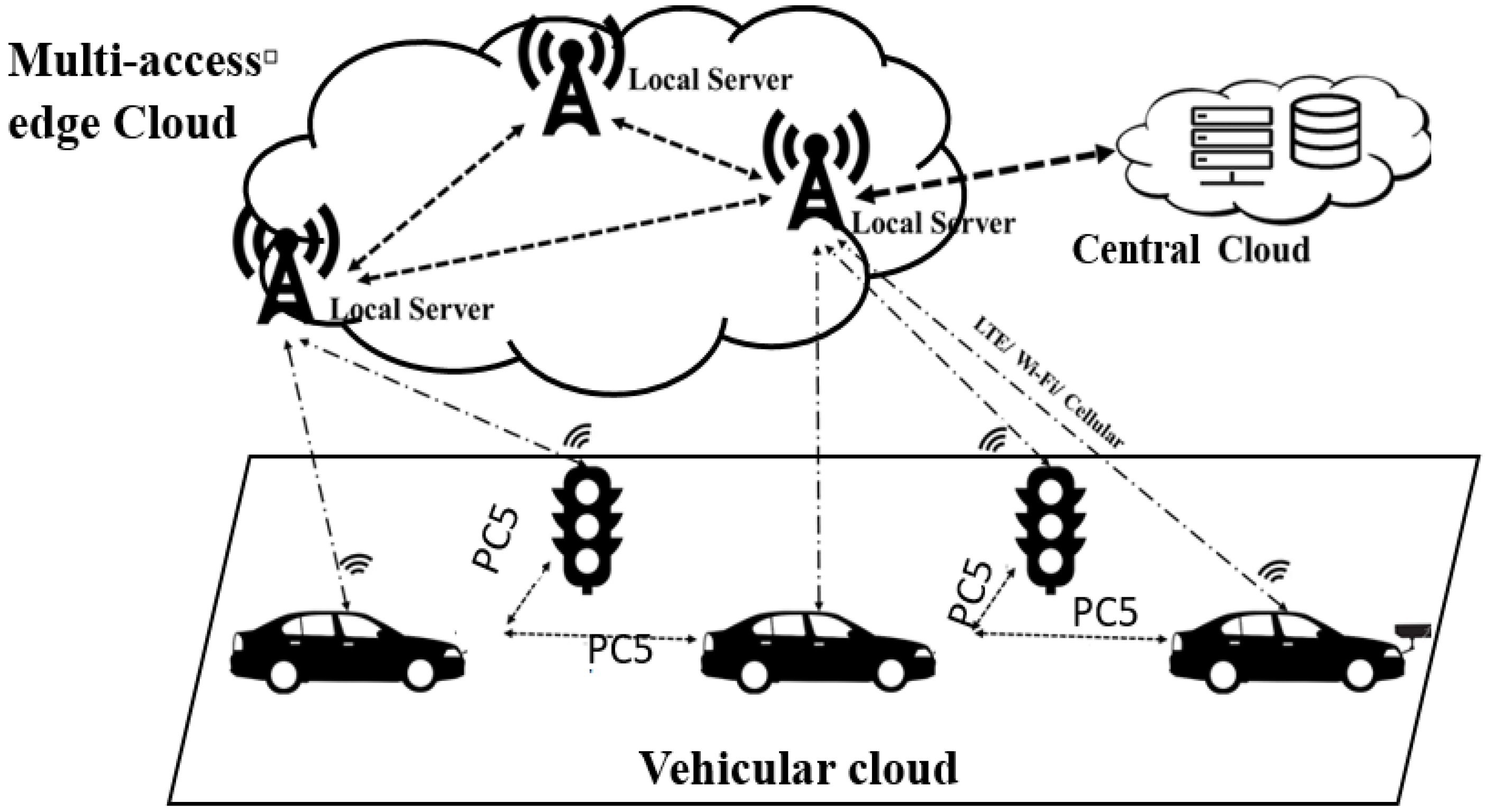
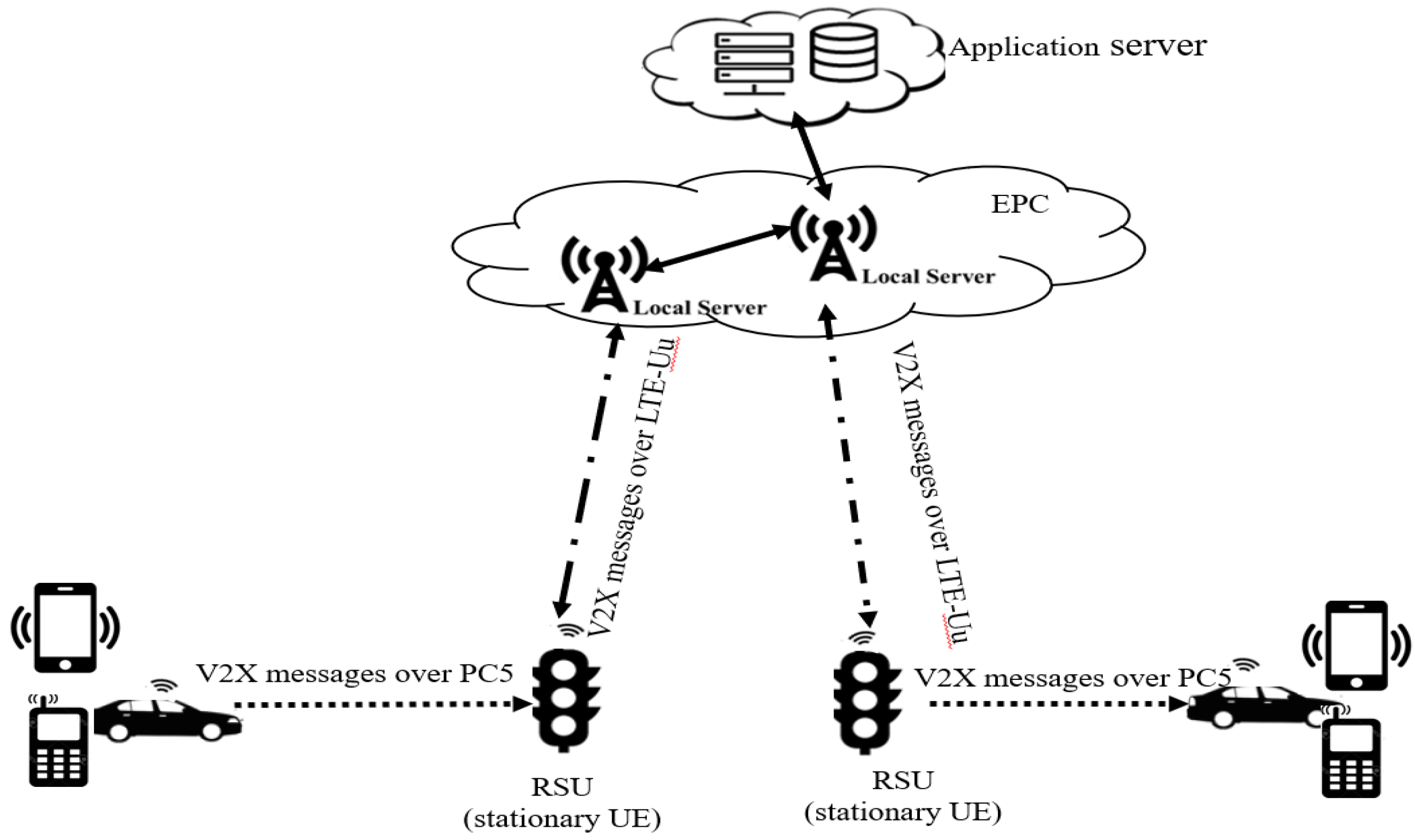
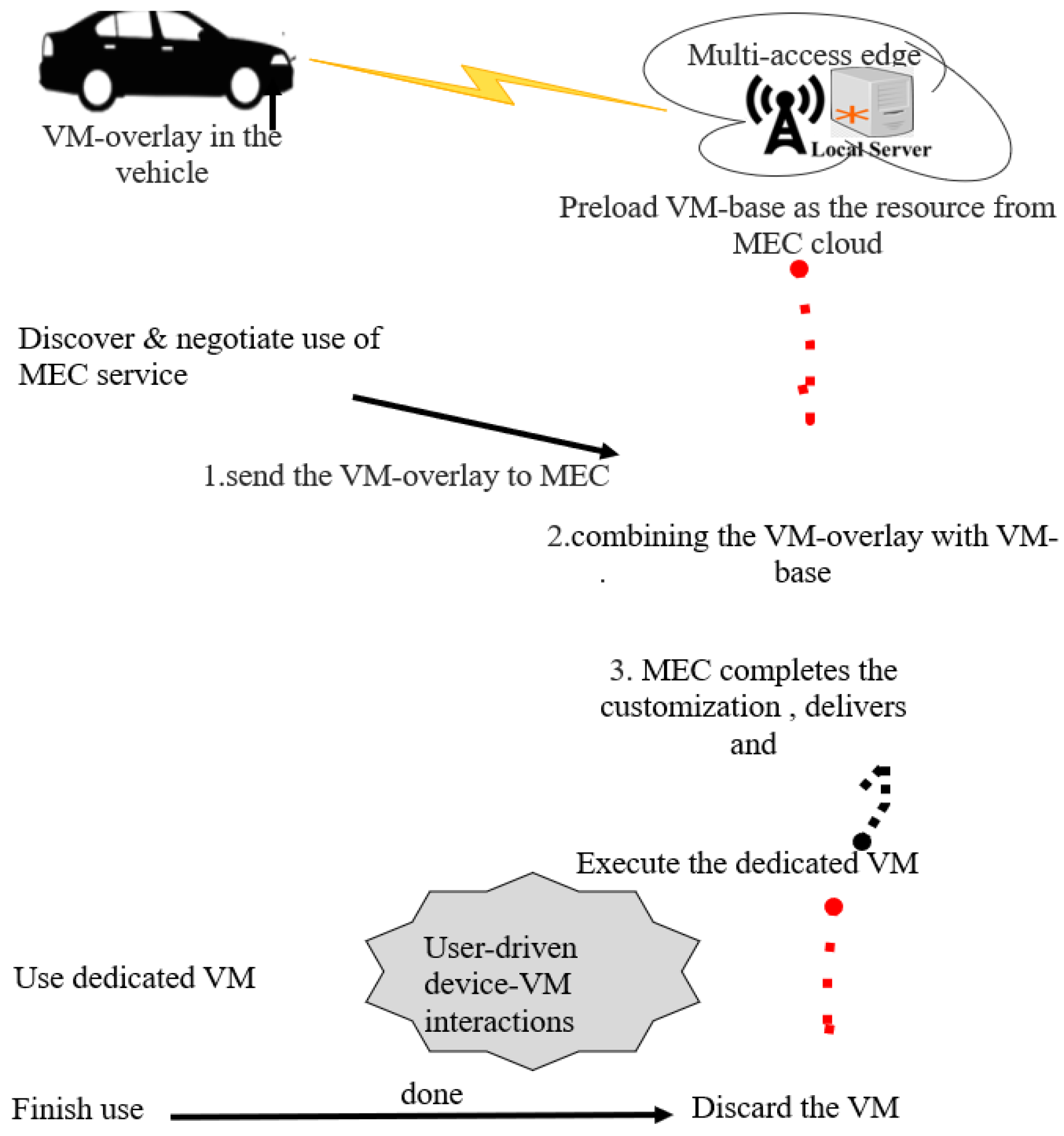
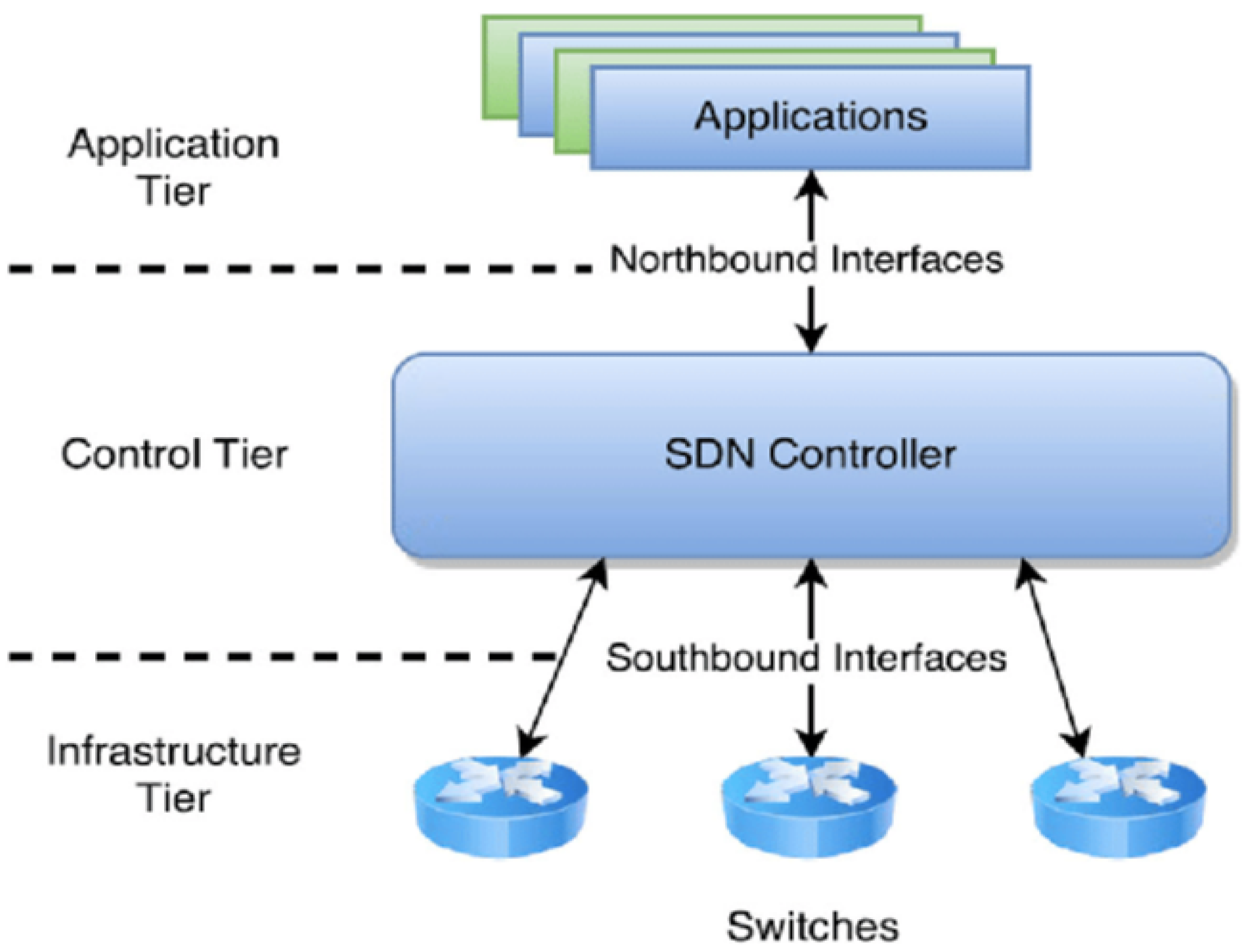
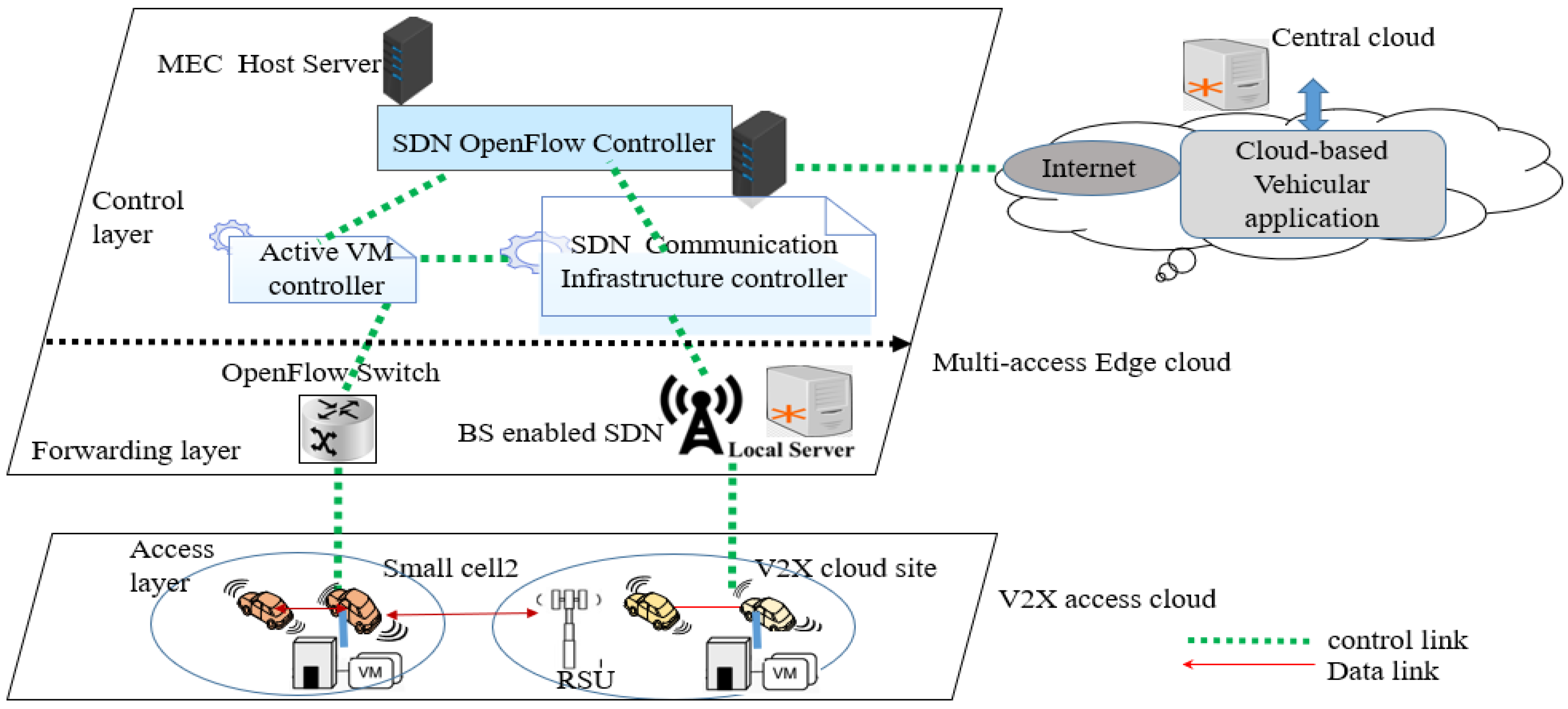
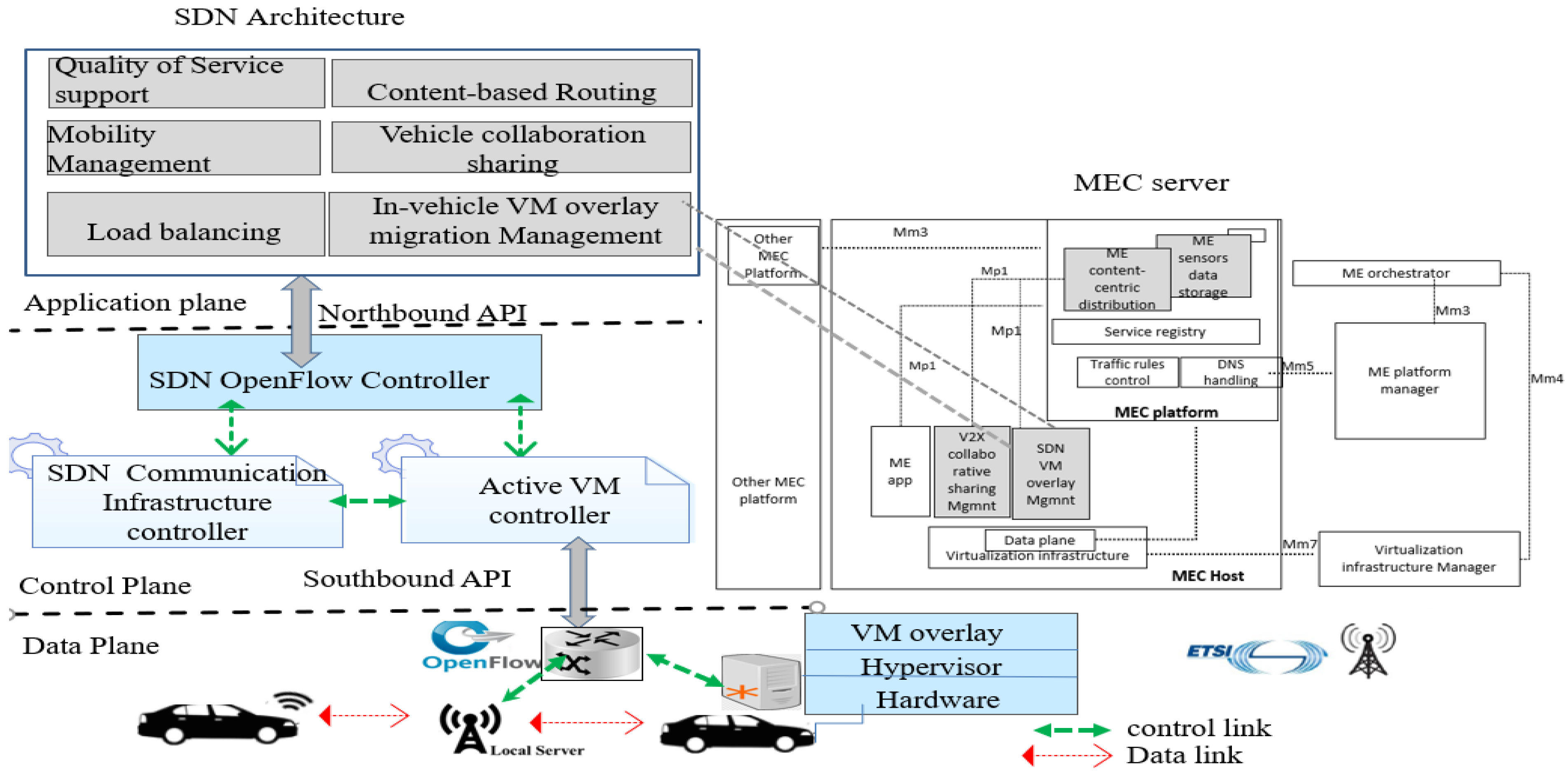
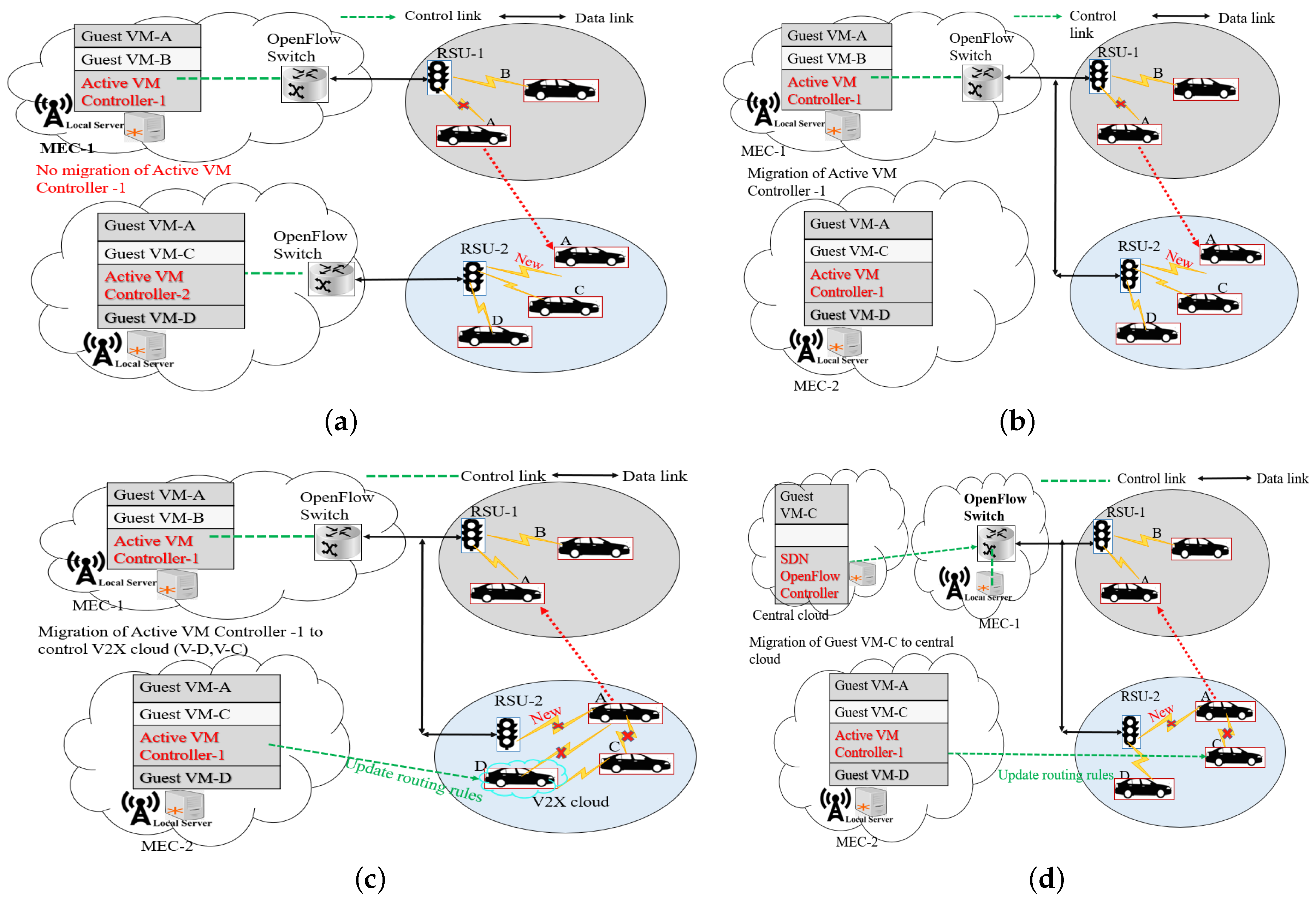
| Relevant SDN Controllers Assistance | Resource Sharing | ||||||
|---|---|---|---|---|---|---|---|
| Potential Application | SDN OpenFlow Controller | SDN Communication Infrastructure Controller | Active VM Controller | Computation | Storage | Bandwidth | Latency (ms) |
| Real-time traffic condition analysis and broadcast | √ | √ | √ | √ | √ | 10–100 [40] | |
| Real-time car navigation | √ | √ | √ | √ | 430–460 [41] | ||
| Video surveillance | √ | √ | √ | 120–200 [42] | |||
| LBS commercial advertisement | √ | √ | √ | √ | 10–100 [40] | ||
| Mobile Social networking | √ | √ | √ | √ | √ | 10–100 [43] | |
| In-vehicle multimedia entertainment | √ | √ | √ | √ | √ | 10–100 [40] | |
| Intervehicle video and audio communications | √ | √ | 10–100 [43] | ||||
| Remote Vehicle Diagnostics | √ | √ | √ | √ | 10–100 [40] | ||
| location-based services recommendation based on personalized and precise service [44] | √ | √ | √ | √ | √ | 10–65 [44] | |
| SDVN Proposal and Its Computing Resources Architecture | Year | Approach to VM Migration | Simulation Tools | Use Cases |
|---|---|---|---|---|
| [21], central cloud | 2017 | none | not specified | update softwares on vehicles |
| [48], Fog computing | 2017 | none | not specified | geographic placement of the SDN controllers |
| [36], central cloud | 2018 | none | Mininet-Wifi and emulation platform for evaluation of smart cloud applications | QoS and routing applications |
| [49], central cloud | 2016 | Fellow Me Cloud prototype | software-defined networking-based follow-me cloud testbed | evolution of service latency during and after the migration process |
| [50], RSU cloud | 2015 | reconfiguration overhead related to VM migration | Mininet | not specified |
| [51], multi-access edge computing | 2019 | none | not specified | bandwidth management for Connected Autonomous Vehicle |
| [52], multi-access edge computing | 2018 | none | Minenet-WiFi | V2X slice for cooperative driving services |
| [53], vehicular cloud | 2016 | none | none | not specified |
| [47], fog computing | 2018 | none | OMNeT++, SUMO [55] | content distribution |
| [46], edge computing | 2018 | none | not specified | content dissemination |
| [45], edge computing | 2018 | none | Mininet-WiFi, SUMO | content distribution |
| [9], edge computing | 2016 | none | not specified | content dissemination |
| Strategies for VMM | Mobility Prediction | Vehicular Cloud | Cost on VMM | RSU | Fog Computing | Migration Policies | SDN Concept | Reduce VM Failures | Resources Management |
|---|---|---|---|---|---|---|---|---|---|
| MyiFogSim [60] | √ | √ | √ | √ | √ | ||||
| Fellow-Me Edge [61] | √ | √ | √ | √ | √ | ||||
| pre-copy based Live VM [62] | √ | √ | √ | ||||||
| proactive service replication [63] | √ | √ | √ | √ | √ | ||||
| VM-based RSUCloudlet [4,64] | √ | √ | √ | √ | |||||
| MDP-based service Migration [49,65] | √ | √ | √ | √ | √ | ||||
| Time window based Service Migration [66] | √ | √ | √ | √ | √ | ||||
| Predictive VMM [67] | √ | √ | √ | √ | √ | √ | |||
| Vehicular Virtual Machine Migration [68] | √ | √ | √ | √ | √ | √ | |||
| location-based VMM [69] | √ | √ | √ | √ |
© 2020 by the authors. Licensee MDPI, Basel, Switzerland. This article is an open access article distributed under the terms and conditions of the Creative Commons Attribution (CC BY) license (http://creativecommons.org/licenses/by/4.0/).
Share and Cite
Nkenyereye, L.; Nkenyereye, L.; Adhi Tama, B.; Reddy, A.G.; Song, J. Software-Defined Vehicular Cloud Networks: Architecture, Applications and Virtual Machine Migration. Sensors 2020, 20, 1092. https://doi.org/10.3390/s20041092
Nkenyereye L, Nkenyereye L, Adhi Tama B, Reddy AG, Song J. Software-Defined Vehicular Cloud Networks: Architecture, Applications and Virtual Machine Migration. Sensors. 2020; 20(4):1092. https://doi.org/10.3390/s20041092
Chicago/Turabian StyleNkenyereye, Lionel, Lewis Nkenyereye, Bayu Adhi Tama, Alavalapati Goutham Reddy, and JaeSeung Song. 2020. "Software-Defined Vehicular Cloud Networks: Architecture, Applications and Virtual Machine Migration" Sensors 20, no. 4: 1092. https://doi.org/10.3390/s20041092
APA StyleNkenyereye, L., Nkenyereye, L., Adhi Tama, B., Reddy, A. G., & Song, J. (2020). Software-Defined Vehicular Cloud Networks: Architecture, Applications and Virtual Machine Migration. Sensors, 20(4), 1092. https://doi.org/10.3390/s20041092






